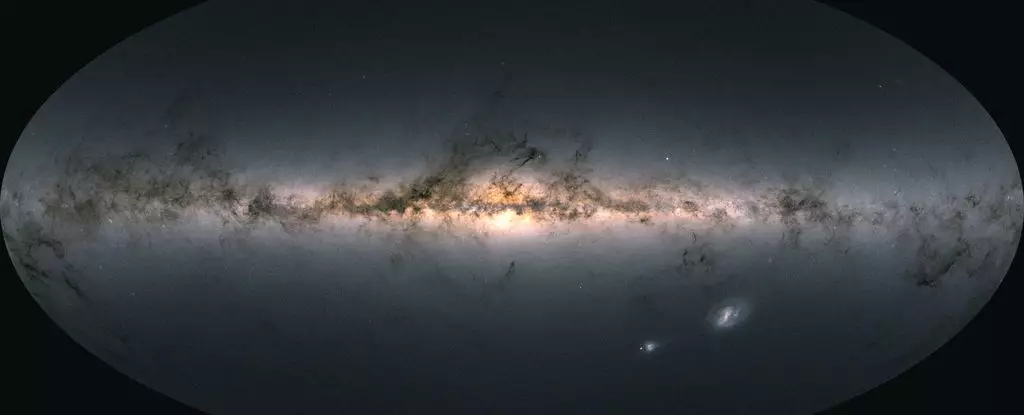The cosmos is an expanse rich with enigmas, one of the most profound being black holes. Recent revelations suggest that a new black hole, lurking deep within the Large Magellanic Cloud (LMC)—a dwarf galaxy that spirals around our Milky Way like a celestial satellite—may prove to be a significant factor in our galaxy’s future. This black hole, weighing around 600,000 times the mass of our sun, is an intriguing specimen that challenges our conventional understandings of black hole formation and growth. This discovery, spearheaded by Jiwon Jesse Han and his team at the Harvard & Smithsonian Center for Astrophysics, beckons further investigation and raises essential questions about the mechanics of our universe.
The Large Magellanic Cloud is not just a passive observer in our cosmic neighborhood; it is destined to collide with the Milky Way. As these two galaxies perform their slow, intricate dance, they draw closer together over billions of years. The gravity of this potential collision suggests that the hidden black hole within the LMC is also on a collision course with our galaxy, promising to add another layer of complexity to the already dynamic interactions between galaxies. Understanding this inevitable meeting point is crucial for astrophysicists, as it could unveil the processes that enable black holes to evolve from smaller entities into the titans that dwarf entire solar systems.
Identifying black holes is notoriously a Herculean task. They do not emit light or radiation unless they are actively consuming matter—an event that generates significant heat and light. Most black holes remain invisible, lurking undetected until their presence is inferred through indirect means. One prevalent method involves observing the movement patterns of nearby stars. Anomalies in stellar orbits can indicate the mass and influence of a hidden black hole. For example, the mass of Sagittarius A*, the supermassive black hole at the center of our galaxy, was established by analyzing the orbits of nearby stars.
However, Han’s research took a different route. Rather than focusing on stellar orbits, the team explored the phenomena of hypervelocity stars—energetic stars flung at incredible speeds through the galaxy. The specific scenario, known as the Hills mechanism, describes a three-body interaction that results in one star being expelled at such velocities that it can escape the gravitational clutches of its home galaxy. This highly unusual stellar behavior may be the key to uncovering hidden black holes that are otherwise imperceptible.
The analysis presented by Han and his colleagues benefited immensely from data collected by the retired Gaia space telescope. Gaia dedicated a significant part of its mission to meticulously mapping the positions and velocities of millions of stars, providing crucial three-dimensional spatial information that is paramount in our quest to understand the cosmos. By leveraging this data, the researchers scrutinized the trajectories of 21 hypervelocity stars within the Milky Way’s outer halo, correlating their paths to the Hills mechanism and subsequently linking them to a massive invisible object.
The implications of their findings are profound. The researchers were able to trace the origins of these hypervelocity stars back to the LMC, a revelation that corroborates the theory of a black hole’s existence in that region. Detecting hypervelocity stars that originated from both the center of the Milky Way and the Large Magellanic Cloud creates a fascinating tapestry that intertwines the fates of these cosmological bodies.
The distance between our Milky Way and the Large Magellanic Cloud currently stands at approximately 160,000 light-years. The eventual collision of these two galaxies is not just a matter of proximity; it signifies a process that could lead to the formation of new black holes and possibly the merger of existing ones. If validated, the existence of this newly inferred black hole could reveal insights into how these enigmatic entities grow through galactic mergers over time.
While the predicted merger of the Milky Way and the LMC is on a cosmic timescale—estimated to take place in about two billion years—the process of black hole accumulation and growth could potentially offer us an extraordinary glimpse into the workings of gravitational forces and mass accumulation, perhaps one of the universe’s most fascinating narratives.
The discovery raised by Han and his team is merely a stepping stone in the vast realm of astrophysical exploration. As the scientific community continues to explore these mysteries, ongoing research efforts will be critical in confirming the existence of this hidden black hole and better understanding its properties. The study of such phenomena not only expands our knowledge of the universe but also feeds into the larger existential questions surrounding our place within it.
The existence of a 600,000-solar-mass black hole in the Large Magellanic Cloud embodies both the known and the unknown of our cosmos. As we peer deeper into the galactic void, we inch closer to illuminating the shadows cast by these enigmatic entities, piecing together the intricate puzzle of black hole formation and evolution to reveal a narrative that is as compelling as it is complex.


Leave a Reply